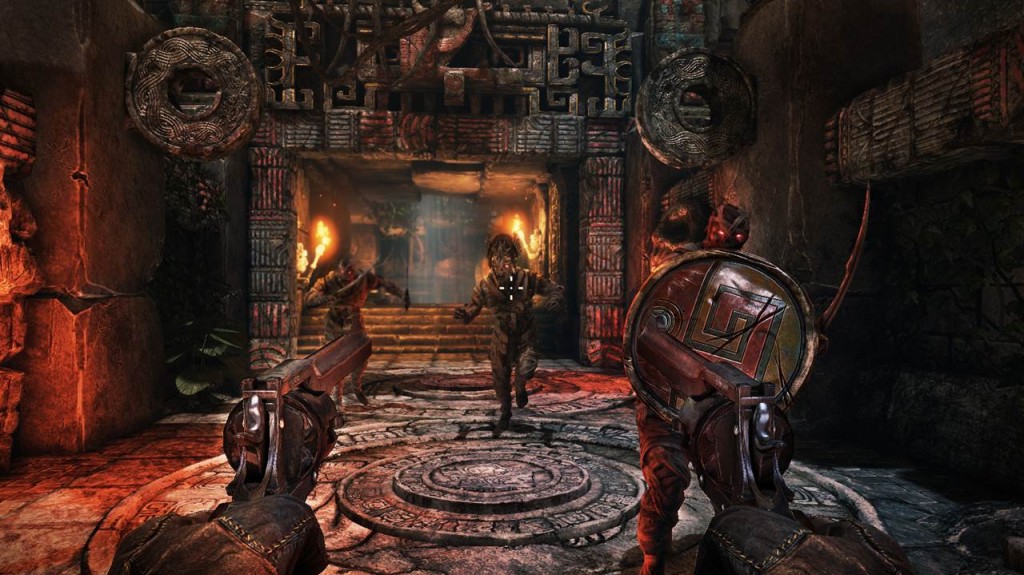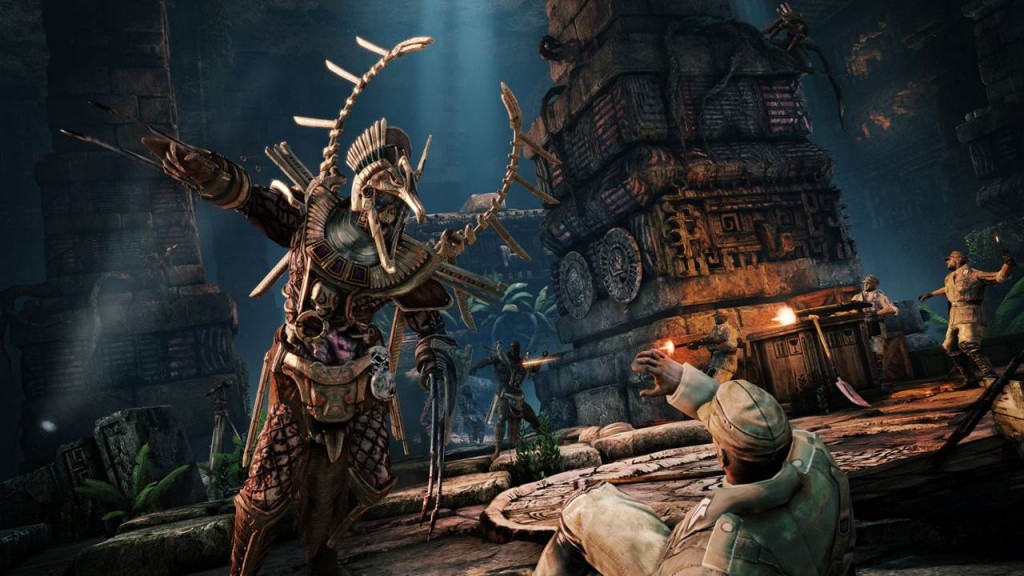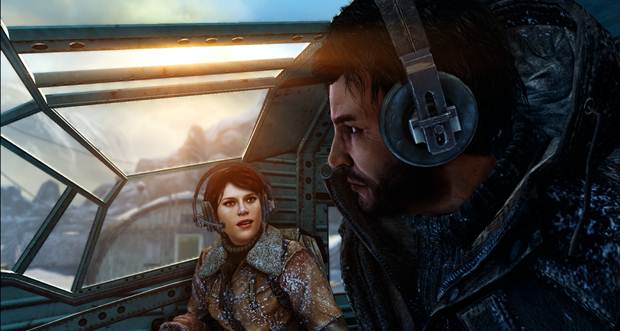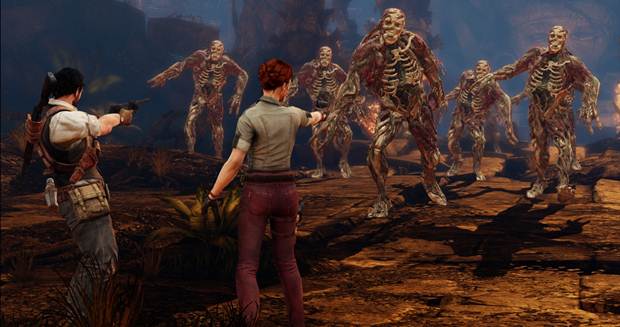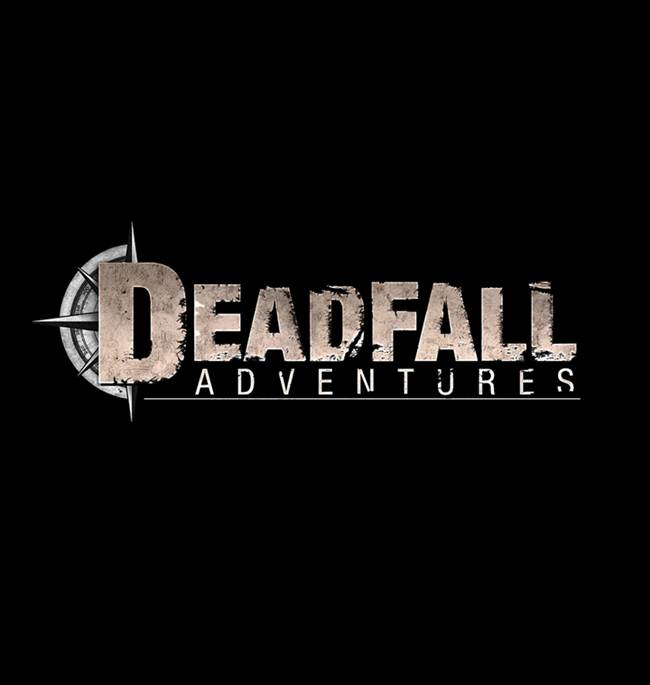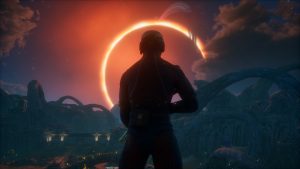
It’s 1938 and you play as James Quatermain, great-grandson of one of the world’s greatest adventures Allan Quartermain. Just like his grandfather James Quartermain is also an adventurer, but unlike his grandfather he doesn’t believe in the superstitious tales that popularized his grandfather’s journeys.
Taking on an adventure of escorting the young and keen US Agent, Jennifer Goodwin on a trip across the globe, the aim of this roller coaster of a journey is to find an ancient artifact known as the Heart of Atlantis. Despite his disbelief in the magical properties that are said to be contained within the artifact, James goes along with this charade and winds up going head to head with a group of Nazis, hellbent on seeking the artifact for themselves.
"The game's credibility should be seen as something which holds true from it's translation of the book medium into a game, rather than a game it just so happens to resemble. Besides who said a "first-person Uncharted" could ever be a bad thing?"
Without a doubt Deadfall will be labeled by many as a “First-person Uncharted Wannabe”. But the fact that the Uncharted series is essentially a Tomb Raider for the modern era, and tries so hard to imitate Indiana Jones, this defends Deadfall from being a rip-off, seeing as Deadfall is based on H.R. Haggard’s Quartermain books which where written in the late 1800’s to the early 1900’s.
The universe for this series was already set in stone long before Nathan Drake was even in diapers. The game’s credibility should be seen as something which holds true from it’s translation of the book medium into a game, rather than a game it just so happens to resemble. Besides who said a “first-person Uncharted” could ever be a bad thing?
There’s no getting away from the fact that the game’s main menu is directly taking ques from Uncharted’s universe. This is obvious within the game audio, background scenery, and the overall vibe that you’ve been here, seen this, and done that before. Assuming you’ve already played those games that is. The main menu gives you the option to adjust both the game’s difficulty and puzzle difficulty separately, seeing as the game places a heavy emphasis on puzzle solving it’s worth taking this into account. How well the game pulls these puzzle elements off is another story entirely.
"The notebook basically solves the puzzles of the game by pointing you in the right direction through the use of highlighted environmental objects. It appears as a tacked in version of detective mode seen in Rocksteady's Batman Arkham series."
Including the main star of the game, James Quartermain, the game does nothing to extend on character development or build any form of attachment or bond with the other characters in the game. James is about as interesting as water is to goldfish. The failure to extend on his character lets the game down, and where the game’s strengths are noticeably exceptional in other parts, it’s a shame. This is no different for Jame’s companions either. By the time you reach the third hour of the game you’ll come to the conclusion that the most conversation you’ll ever receive from the supporting roles, are nothing more than repetitive dialogue attempting to resolve puzzles and environmental obstacles. Jennifer Goodwin’s lackluster lines caused me to mute the television due to the repetition in her dialogue and the unbalancing of puzzle difficulty.
The star of the game is the adventure mode itself, with a thrown in multi-player and survival mode. As mentioned before the game plays in first-person, but gives itself a little more depth in terms of what’s actually seen on screen. It’s apparent to you that this is a first-person shooter but the ability to hold a torch, notebook, and a compass in combination with your arsenal of guns delivers that added touch and well placed design, of being an adventurer.
Playing the game on an easy setting, the level of difficulty within the puzzles hold no consistency whatsoever. While some prove to be a frustrating obstacle others tend to be a hit or miss that will have you frozen in time, or progress ahead with luck. The notebook basically solves the puzzles of the game by pointing you in the right direction through the use of highlighted environmental objects. It appears as a tacked in version of detective mode seen in Rocksteady’s Batman Arkham series.
"Fights with the supernatural beings of the games such as Mummies are what give the game its strides. Although dealing with such creatures runs on the Alan Wake formula of "Here's a torch, they're creatures of darkness and evil, shine and shoot" it's actually more enjoyable than facing human foes and is a nice change of pace."
This provides no sense of accomplishment whatsoever and should have just been titled “Auto-Solve”. But the constant fluctuation of difficulty that ranges from one puzzle to the next had me up in arms at times. The puzzle’s attempt to hold a positive and valid reason for being in the game lies, within its encouragement for getting you to explore the game’s environment and interact with it.
But this falls flat in some places as some paths and new found routes are essentially empty and pointless. The game’s attempt to balance action and combat with that of the puzzle sections is a failure. Combat scenarios are often the cause of you trying to reach a certain destination only to be held off by thugs and henchmen. These set of brainless goons wouldn’t know the meaning of A.I. and they could learn a thing or two from the supernatural enemies that turn up later on in the game.
While it could be said that this was down to the game’s difficulty setting of being played on easy, it doesn’t do anything to justify the reasoning for appalling combat. Fights with the supernatural beings of the games such as Mummies are what give the game its strides. Although dealing with such creatures runs on the Alan Wake formula of “Here’s a torch, they’re creatures of darkness and evil, shine and shoot” it’s actually more enjoyable than facing human foes and is a nice change of pace.
"When the opportunity arose for me to upgrade my gear I only did so for the sake of feeling obliged too. I could have just as easily progressed through the game in the same manner that I was doing so before."
You will even find yourself retreating at times as the overall theme of the game does well to present them as a threat. When you’re doing battle with these enemies the design of the environment gives the vibe of arena-based combat. This allows it to be distinctive in contrast to other shooters, and the environmental traps at your disposal give you an aid and provide alot of variety.
Exploration makes sense in this game and feels like you are doing so, and although it holds no bars to that of the original Tomb Raider games, it doesn’t feel shoved in neither. It’s not open world but neither is it linear, it feels just right. This miniature freedom to explore rewards you with finding collectible treasures in a game where it fits right in. It’s still there to serve the needy and gimmicky of finding things in video games, but it also feels right at home. I did encounter one glitch in the game in that I fell while rotating a frozen bridge, only to be trapped on the floor below with no way back and one bullet left in my pistol. Had this been a real adventure it would have been the ultimate death wish. Freeze to death or pull the trigger, and after 2 minutes wondering the frozen circle of glitch I pulled back a grenade.
Upgrades to Quartermain’s weapons and flashlight can be achieved by finding hidden treasures throughout the game’s environments, then visiting upgrade locations. Upgrades move at a slow pace and the feeling that your upgrades are making a difference feels largely abundant. When the opportunity arose for me to upgrade my gear I only did so for the sake of feeling obliged too. I could have just as easily progressed through the game in the same manner that I was doing so before.
"Traveling from the dusty pyramids of Egypt onto treacherous jungles and the icy tombs of the arctic, the game's visuals go through a rather massive change up, and manages to remain beautiful in all of its content. Working hand in hand with music cues and sound effects, the atmosphere that's passed onto the player can be immense at times."
Your arsenal of weapons are those that exist within its time. You are provided with the usual classes of guns like an assault rifle, shotguns, pistols, and rifles of the late 1930s. Some may find this unusual in comparison to the onslaught of modern and futuristic military shooters that swamp the current gaming generation. But the change of gun play here feels fresh and a joy to play. With the selection of weapons available to you, choices of other weapons exist within that class range. So while you’re never starved for weapons and have plenty of variety, you can also dual-wield your pistols, melee a combat knife and pick up those of fallen enemies.
Traveling from the dusty pyramids of Egypt onto treacherous jungles and the icy tombs of the arctic, the game’s visuals go through a rather massive change up, and manages to remain beautiful in all of its content. Working hand in hand with music cues and sound effects, the atmosphere that’s passed onto the player can be immense at times. Not once do you question the authenticity of the game’s level design, as each and every section feels true to the environment in which it’s trying to replicate. In short, exploring a pyramid feels like Egypt, and trying to find your way out from an icy tomb is chilling.
It’s easy to point out which parts could have taken more effort or gone the extra mile, but overall the game looks amazing. PC gamers will be pleased to know it’s fairly scalable across the graphical options, and will run on on modern computer. Though the game is no Crysis it’s decent for what its worth and looks great regardless.
"In a game which puts the majority of its resources and focus on delivering a strong story in its single player campaign, the need to throw in a mulltiplayer felt exactly how it sounds, thrown in."
Despite the option to play with a game pad rather than a mouse and keyboard, the game provides no options for sensitivity or button remapping. The controls remain standard however and are largely no different from any other first-person shooter.
In a game which puts the majority of its resources and focus on delivering a strong story in its single player campaign, the need to throw in a mulltiplayer felt exactly how it sounds, thrown in. This is a game where the story is where the heart is and while multiplayer carries over some of its features, and the influence is present. It’s not something that’s wanted or will be highlighted in a discussion among peers.
The multiplayer problem that exists within many of today’s shooters is down to the person and preference. Some may find the single-player campaign to be somewhat of an amazement but will undoubtedly drift to another game for a multiplayer experience. The game takes its own spin on the traditional modes of the multiplayer in first-person shooters, but doesn’t do enough to make it stand out or bring anything new to the table. A Deathmatch, Team Deathmatch, and Capture the flag are all here, and they prove to be nothing more than an entree to the main course which is the campaign mode.
This game was reviewed on the PC.
An enjoyable experience that draws you in with the element of adventure.
The upgrade system could have been worked upon more and puzzles can be tedious.









